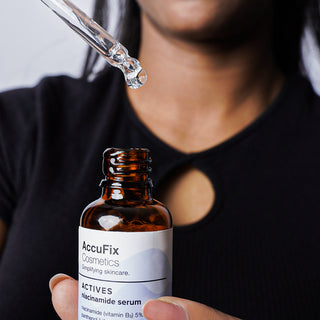Niacinamide (also called vitamin B3) is a gentle but powerful ingredient. It helps with many skin problems—like acne, dark spots, and large pores. It’s one of the most loved ingredients in skincare today, and there’s a lot of science to prove it works.
In this blog, we’ll talk about what niacinamide does, why it’s so good for your skin and its benefits, how to use it, and who can use it safely.
What Does Niacinamide Do for Your Skin?
Let’s look at the top reasons why skin experts love niacinamide:
1. Fades Dark Spots
One of the best things niacinamide does is fade dark spots and even out skin tone. A study showed that using 5% niacinamide for just four weeks helped reduce dark patches and made skin look clearer. It does this by stopping too much pigment (melanin) from reaching the top layer of skin.

2. Makes Pores Look Smaller
You can’t shrink pores, but niacinamide helps control oil, which makes pores look smaller. This can also help your skin feel smoother, especially if you have oily or acne-prone skin.
3. Makes the Skin Barrier Stronger
Niacinamide helps your skin make more ceramides. These are natural fats that keep your skin barrier strong and healthy. A strong skin barrier holds in moisture better and helps protect against dryness and irritation.
4. Controls Extra Oil
If your skin gets oily, niacinamide can help with that too. Using 2% to 4% niacinamide can lower how much oil your skin makes without drying it out.

5. Helps reduce Acne and Redness
Niacinamide calms the skin. It can reduce the redness and swelling that come with pimples. Some studies even say it works as well as acne creams with antibiotics—without the risk of antibiotic resistance.
6. Calms Sensitive Skin
Got redness or sensitive skin? Niacinamide can help soothe it. It’s great for people with rosacea or skin that gets irritated easily. It also protects your skin from damage caused by pollution and sunlight.
7. Slows Signs of Aging
Niacinamide helps your skin make more collagen, which keeps it firm. Over time, it can make fine lines and wrinkles less noticeable. It works slower than retinoids but is much gentler on your skin.

How to Use Niacinamide in Your Skincare Routine
The good news? Niacinamide is super easy to add to your routine. And it works well with most skincare ingredients.
How to Apply It
You can use niacinamide in the morning or at night—or both. Use it after you wash your face, but before thick creams or oils. It soaks in fast and won’t mess up the rest of your skincare.
Types of Products You Can Use
- Serums: These usually have 5% to 10% niacinamide. Our Niacinamide Serum has 5% niacinamide, panthenol, and hyaluronic acid. It helps even skin tone, control oil, shrink pores, and protect your skin barrier.

- Moisturizers: These usually contain 2% to 5% niacinamide to keep skin soft and smooth. Our Crème B3-B5-E has 4% niacinamide, plus vitamin B5 and E. It hydrates the skin, fixes uneven tone, and improves texture.

Can You Use Niacinamide with Other Ingredients?
Yes! Niacinamide is safe to use with vitamin C, retinol, hyaluronic acid, and exfoliating acids. Just don’t use too many strong ingredients at once. Keep things balanced.
When Will You See Results?
2–4 Weeks:
You might see less redness, smoother skin, and more glow. Some people also see smaller-looking pores and a more even tone early on.
6–12 Weeks:
This is when you’ll see bigger changes—like faded dark spots, fewer breakouts, and firmer skin. Be patient and use it daily for the best results.
Niacinamide: Skincare vs. Food and Supplements
Is Niacinamide in Food Enough?
Niacinamide is in foods like eggs, meat, fish, and green veggies. But the amount in food isn’t enough to fix skin problems. That’s why skincare products are better for your skin.
When you apply niacinamide on your skin, it goes right to the cells that need it—helping with oil, pigment, and hydration from the outside in.
What About Supplements?
Niacin (a form of vitamin B3) in pills can help with energy and cholesterol. But it won’t clear your skin like a serum can.
Is Niacinamide Safe for Everyone?
Yes—most people can use it without any problems. It’s one of the safest and most stable ingredients in skincare.
For Sensitive Skin:
If your skin is very sensitive, start with a lower amount (like 2% to 5%) and do a patch test.
How to Patch Test:
Put a small amount behind your ear or on your jawline. Wait 24 hours. If there’s no redness or stinging, you’re good to go!
Conclusion
Niacinamide is a skin superhero. It helps with dark spots, acne, large pores, redness, dryness, and signs of aging. It’s gentle, powerful, and easy to use.
If you want glowing, healthy skin without using harsh treatments, niacinamide might be just what you need.

